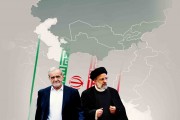Publish Date
Monday 23 August 2021 - 14:04
recommended
0
Prospects for Uzbekistan's multilateral efforts for the Afghan Trans-Corridor
Transit is one of the key issues in landlocked Central Asia. The region is deprived of sea routes; hence, has to pay more in transit for trade with partners beyond Eurasia. This is a serious obstacle, especially for countries such as Uzbekistan, with a coherent and well-codified action plan of economic and trade growth. Accordingly, the foreign policy of Central Asian republics has evaluated the diversification of transit routes and the maximum reduction of transportation costs. However, Afghanistan's critical geopolitics in the south and the lack of strategic infrastructure around the region has prevented full implementation of this strategy.
Transit is one of the key issues in landlocked Central Asia. The region is deprived of sea routes; hence, has to pay more in transit for trade with partners beyond Eurasia. This is a serious obstacle, especially for countries such as Uzbekistan, with a coherent and well-codified action plan of economic and trade growth. Accordingly, the foreign policy of Central Asian republics has evaluated the diversification of transit routes and the maximum reduction of transportation costs. However, Afghanistan's critical geopolitics in the south and the lack of strategic infrastructure around the region has prevented full implementation of this strategy. But it has not stopped Uzbekistan from doing more efforts. As an example, we can refer to the Trans-Afghan Corridor, which provides access to open seas through Afghanistan and Pakistan. In this context, we have arranged an interview with Mr.Syed Mohd Murtaza. He is doing Ph.D. on India-Central Asia relations from Academy of International Studies in Jamia Millia Islamia University (New Delhi).
IESS: The Trans-Afghan Corridor is one of the initiatives designed to connect Central and South Asia (from Uzbekistan to Pakistan). Please tell us about the progress of negotiations and the different routes of this corridor (rail and road)?
The Trans Afghan Corridor is another project that will open doors for Uzbekistan and other Central Asian states up to Arabian Sea and give it quick access to larger Indian Ocean countries. This railroad route runs through Uzbekistan, Afghanistan and up to Gwadar Port in Southern Pakistan. The government of Uzbekistan is working on Trans-Afghan Corridor that runs parallel to western counterpart or route that turns towards Iran and up to sea ports of Chabahar and Bandar Abbas in Persian Gulf. Both of these routes will give sea access to Uzbekistan and other Central Asian states.
At present the pace of Trans-Afghan Corridor getting shape is quicker than expected if we compare it with the route that runs deep into southern Iran. In the last few months, Uzbekistan has paid extra effort that also includes the first bilateral meeting between Uzbek President Shavkat Mirziyoyev and Pakistani Prime Minister Imran Khan. It does not mean that Uzbekistan is losing interest in Chabahar. In December 2020, Prime Minister Narendra Modi and President Mirziyoyev held a virtual summit and just three days later Iran, Uzbekistan and India held their first trilateral working group meeting regarding the joint use of Chabahar Port in Iran. It is just that Uzbekistan wants to keep both options open and it was conveyed to Foreign Minister of Iran Javad Zarif during his April visit to Uzbekistan.
The Trans-Afghan Corridor (Uzbekistan to Pakistan via Afghanistan) is supposed to join Termez in Uzbekistan to Mazar-e-Sharif in Afghanistan and then go through Kabul and Peshawar in Pakistan. Termez already has a rail link up to Mazar-i-Sharif via Hairatan. The corridor’s new rail link i.e. from Mazar-i-Sharif to Peshawar would be 600 km and it will join the road network in Pakistan up to Gwadar and Karachi ports.
IESS: Financing is one of the most important issues in advancing such intergovernmental projects. Based on TAPI's experience, do you think that this time the partners will be able to finance this project? How?
Uzbekistan is working very hard to ensure that the Trans-Afghan Corridor becomes reality and recent reports suggest that they want to start construction of a railroad link till Kabul by September 2021. If we compare it with TAPI, the partner countries i.e. Uzbekistan, Afghanistan and Pakistan are acting very fast on the Trans Afghan corridor. Although the TAPI pipeline project may see the light by next year, it is running well behind its deadlines that keep shifting year by year. For Trans-Afghan Corridor, the U.S. International Development Finance Corporation (IDFC) formed Central Asian Investment Fund to fund such big projects. In December 2020, Afghanistan, Pakistan and Uzbekistan planned to seek a $4.8 billion loan for this project. Uzbekistan's media reported that the World Bank, European Bank for Reconstruction and Development, Islamic Development Bank expressed their interest in the project. Even the Asian Development Bank (ADB) which also fuels the TAPI project is reported to be interested in funding the Trans-Afghan Corridor. Apart from funding, at present this project can be another game changer for Afghanistan in terms of revenue generation and the thousands of jobs it will create in Afghanistan. This project has the backing of the United States and even the Taliban is positive about this corridor.
IESS: One of the alternative routes for the Trans Afghan Rail Corridor (Termez -Mazar-e-Sharif-Kabul-Peshawar) is the Iran-Central Asia Rail Corridor via Afghanistan (Termez -Mazar-e-Sharif-Herat-Khaf). In your opinion, what are the advantages and disadvantages of each of these two corridors for Central Asian Republics?
After the Trans Afghan corridor gets operational, the Central Asian states will have three routes to reach the Indian Ocean region or the South Asia or markets of South East Asia. One will go through Afghanistan and Pakistan, the second through Iran and the third will pass over Afghanistan and Iran. The main factors that will play an important role in these rail-road trade routes will be security, sanctions and cost effectiveness. At present, factors like security and sanctions are dynamic in nature till they get addressed with some permanent solutions. The Trans Afghan corridor minus India as destination may not get much traffic as compared to Iran-Central Asia corridor in which India as a market will play an additional important role as one of the biggest destinations of Central Asian goods. Through the Iran route, the Central Asian states will also have the option to connect with INSTC and West Asian countries.
IESS: How will the Trans Afghani corridor affect regional initiatives such as the INSTC and China–Pakistan Economic Corridor? Is it possible to connect to either of these two or weaken them?
INSTC is a very big project and it is touching a wide area not just in Central Asia but also in Eurasia and Europe. The trade volume is going to play a big part. Although the progress of INSTC is slow, India is trying to link it with Uzbekistan and Afghanistan to gain maximum footprint on the heartland. It will reduce the cargo delivery time from 45 days to 25 days and make the transport cost cheaper by thirty percent. Here the role of Iran will play an important part as sanctions on Iran may spoil its true utilization. The second factor is China’s involvement in Iran with $400 billion of investment proposed in the next 25 years. Iran would also like to get itself connected with Chinese market for its natural reserves. In 2019, Javad Zarif proposed to connect Chabahar with Gwadar. Overall INSTC will have its space, the Trans Afghan Corridor (via Pakistan) minus India won’t attract much traffic.
IESS: To what extent do you think this corridor depends on peace talks in Afghanistan?
Success of the Corridor very much depends on safe Afghanistan. And this is the reason that Uzbekistan is also actively engaging with the Taliban. Uzbek Foreign Minister Abdulaziz Kalimov had a meeting in April with Taliban’s important leader Mullah Baradar in Qatar. So far the Taliban has shown interest in such projects that will also give it international legitimacy in Afghanistan. Another point is Pakistan, which is part of the Trans Afghan Corridor and it has close links with the Taliban. The success of this route will give Pakistan new leverage over Indian access to Afghanistan from Iranian side. For the Taliban, such transit will also generate millions of dollars of revenue for Afghanistan. At present, Taliban also wants to have cordial relations with nations which have borders with Afghanistan.
IESS: Can the withdrawal of US troops from Afghanistan accelerate or slow down this project? How?
Just like withdrawal of US troops from Afghanistan or its minimum presence in near future is a reality, the surge of Taliban is something that everyone is expecting. From the US to Russia and Central Asian states every country is engaging with the Taliban. The power struggle that will follow US troops would be an important test for all such projects including TAPI. So far Uzbekistan is trying to bridge all gaps as it is also engaging with the present government of Afghanistan. India has the same apprehensions as it has major investment projects in Afghanistan. India is not directly talking to the Taliban but it has shared its concerns to the United States, Russia and even Iran. Right now it’s a give and take scenario and any major disturbance in Afghanistan with the involvement of Taliban will disturb the ongoing projects. These routes and pipelines are all about big markets, safe routes and destinations. Maybe Pakistan is reluctant about giving transit facilities to Indian trade but minus India, such trade routes or pipelines won’t be a big success economically and in terms of volume of trade.
Post withdrawal of US troops, if revival of Taliban makes Afghanistan unsafe then there is always an alternate route for Uzbekistan to reach Indian Ocean via Persian Gulf. So despite the threat of US sanctions, Iran still calls the shots for safe passage of South Asia bound trade from Central Asia.
IESS: The Trans-Afghan Corridor is one of the initiatives designed to connect Central and South Asia (from Uzbekistan to Pakistan). Please tell us about the progress of negotiations and the different routes of this corridor (rail and road)?
The Trans Afghan Corridor is another project that will open doors for Uzbekistan and other Central Asian states up to Arabian Sea and give it quick access to larger Indian Ocean countries. This railroad route runs through Uzbekistan, Afghanistan and up to Gwadar Port in Southern Pakistan. The government of Uzbekistan is working on Trans-Afghan Corridor that runs parallel to western counterpart or route that turns towards Iran and up to sea ports of Chabahar and Bandar Abbas in Persian Gulf. Both of these routes will give sea access to Uzbekistan and other Central Asian states.
At present the pace of Trans-Afghan Corridor getting shape is quicker than expected if we compare it with the route that runs deep into southern Iran. In the last few months, Uzbekistan has paid extra effort that also includes the first bilateral meeting between Uzbek President Shavkat Mirziyoyev and Pakistani Prime Minister Imran Khan. It does not mean that Uzbekistan is losing interest in Chabahar. In December 2020, Prime Minister Narendra Modi and President Mirziyoyev held a virtual summit and just three days later Iran, Uzbekistan and India held their first trilateral working group meeting regarding the joint use of Chabahar Port in Iran. It is just that Uzbekistan wants to keep both options open and it was conveyed to Foreign Minister of Iran Javad Zarif during his April visit to Uzbekistan.
The Trans-Afghan Corridor (Uzbekistan to Pakistan via Afghanistan) is supposed to join Termez in Uzbekistan to Mazar-e-Sharif in Afghanistan and then go through Kabul and Peshawar in Pakistan. Termez already has a rail link up to Mazar-i-Sharif via Hairatan. The corridor’s new rail link i.e. from Mazar-i-Sharif to Peshawar would be 600 km and it will join the road network in Pakistan up to Gwadar and Karachi ports.
IESS: Financing is one of the most important issues in advancing such intergovernmental projects. Based on TAPI's experience, do you think that this time the partners will be able to finance this project? How?
Uzbekistan is working very hard to ensure that the Trans-Afghan Corridor becomes reality and recent reports suggest that they want to start construction of a railroad link till Kabul by September 2021. If we compare it with TAPI, the partner countries i.e. Uzbekistan, Afghanistan and Pakistan are acting very fast on the Trans Afghan corridor. Although the TAPI pipeline project may see the light by next year, it is running well behind its deadlines that keep shifting year by year. For Trans-Afghan Corridor, the U.S. International Development Finance Corporation (IDFC) formed Central Asian Investment Fund to fund such big projects. In December 2020, Afghanistan, Pakistan and Uzbekistan planned to seek a $4.8 billion loan for this project. Uzbekistan's media reported that the World Bank, European Bank for Reconstruction and Development, Islamic Development Bank expressed their interest in the project. Even the Asian Development Bank (ADB) which also fuels the TAPI project is reported to be interested in funding the Trans-Afghan Corridor. Apart from funding, at present this project can be another game changer for Afghanistan in terms of revenue generation and the thousands of jobs it will create in Afghanistan. This project has the backing of the United States and even the Taliban is positive about this corridor.
IESS: One of the alternative routes for the Trans Afghan Rail Corridor (Termez -Mazar-e-Sharif-Kabul-Peshawar) is the Iran-Central Asia Rail Corridor via Afghanistan (Termez -Mazar-e-Sharif-Herat-Khaf). In your opinion, what are the advantages and disadvantages of each of these two corridors for Central Asian Republics?
After the Trans Afghan corridor gets operational, the Central Asian states will have three routes to reach the Indian Ocean region or the South Asia or markets of South East Asia. One will go through Afghanistan and Pakistan, the second through Iran and the third will pass over Afghanistan and Iran. The main factors that will play an important role in these rail-road trade routes will be security, sanctions and cost effectiveness. At present, factors like security and sanctions are dynamic in nature till they get addressed with some permanent solutions. The Trans Afghan corridor minus India as destination may not get much traffic as compared to Iran-Central Asia corridor in which India as a market will play an additional important role as one of the biggest destinations of Central Asian goods. Through the Iran route, the Central Asian states will also have the option to connect with INSTC and West Asian countries.
IESS: How will the Trans Afghani corridor affect regional initiatives such as the INSTC and China–Pakistan Economic Corridor? Is it possible to connect to either of these two or weaken them?
INSTC is a very big project and it is touching a wide area not just in Central Asia but also in Eurasia and Europe. The trade volume is going to play a big part. Although the progress of INSTC is slow, India is trying to link it with Uzbekistan and Afghanistan to gain maximum footprint on the heartland. It will reduce the cargo delivery time from 45 days to 25 days and make the transport cost cheaper by thirty percent. Here the role of Iran will play an important part as sanctions on Iran may spoil its true utilization. The second factor is China’s involvement in Iran with $400 billion of investment proposed in the next 25 years. Iran would also like to get itself connected with Chinese market for its natural reserves. In 2019, Javad Zarif proposed to connect Chabahar with Gwadar. Overall INSTC will have its space, the Trans Afghan Corridor (via Pakistan) minus India won’t attract much traffic.
IESS: To what extent do you think this corridor depends on peace talks in Afghanistan?
Success of the Corridor very much depends on safe Afghanistan. And this is the reason that Uzbekistan is also actively engaging with the Taliban. Uzbek Foreign Minister Abdulaziz Kalimov had a meeting in April with Taliban’s important leader Mullah Baradar in Qatar. So far the Taliban has shown interest in such projects that will also give it international legitimacy in Afghanistan. Another point is Pakistan, which is part of the Trans Afghan Corridor and it has close links with the Taliban. The success of this route will give Pakistan new leverage over Indian access to Afghanistan from Iranian side. For the Taliban, such transit will also generate millions of dollars of revenue for Afghanistan. At present, Taliban also wants to have cordial relations with nations which have borders with Afghanistan.
IESS: Can the withdrawal of US troops from Afghanistan accelerate or slow down this project? How?
Just like withdrawal of US troops from Afghanistan or its minimum presence in near future is a reality, the surge of Taliban is something that everyone is expecting. From the US to Russia and Central Asian states every country is engaging with the Taliban. The power struggle that will follow US troops would be an important test for all such projects including TAPI. So far Uzbekistan is trying to bridge all gaps as it is also engaging with the present government of Afghanistan. India has the same apprehensions as it has major investment projects in Afghanistan. India is not directly talking to the Taliban but it has shared its concerns to the United States, Russia and even Iran. Right now it’s a give and take scenario and any major disturbance in Afghanistan with the involvement of Taliban will disturb the ongoing projects. These routes and pipelines are all about big markets, safe routes and destinations. Maybe Pakistan is reluctant about giving transit facilities to Indian trade but minus India, such trade routes or pipelines won’t be a big success economically and in terms of volume of trade.
Post withdrawal of US troops, if revival of Taliban makes Afghanistan unsafe then there is always an alternate route for Uzbekistan to reach Indian Ocean via Persian Gulf. So despite the threat of US sanctions, Iran still calls the shots for safe passage of South Asia bound trade from Central Asia.
News code:2754


















